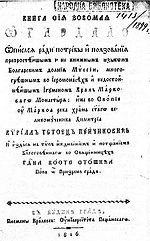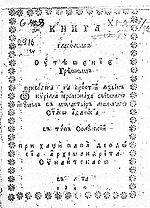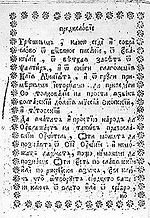
Kiril Peychinovich
Encyclopedia
Kiril Peychinovich or Kiril Pejčinoviḱ ' onMouseout='HidePop("30958")' href="/topics/Old_Church_Slavonic">Church Slavonic
: Күриллъ Пейчиновићь) (c. 1770 – 7 March 1865) was a cleric, writer and enlightener, one of the first supporters of the use of modern Bulgarian in literature (as opposed to Church Slavonic), and one of the early figures of the Bulgarian National Revival
. In the Republic of Macedonia
Peychinovich is considered one of the earliest contributors to modern Macedonian literature, since most of his works were written in his native Lower Polog dialect
which he called most common and illiterate Bulgarian language of Lower Moesia.
village of Tearce
(Теарце) in present day Republic of Macedonia
(then part of the Ottoman Empire
). His secular name is unknown. According to his tombstone, he received his primary education in the village of Lešok (Лешок). Probably he later studied at the Monastery of St. John Bigorski
near Debar
. Kiril's father, Peychin, sold his property in Tearce and, together with his brother and his son, moved to the predominantly Bulgarian monastery of Hilandar
in Mount Athos
where the three became monks. Peychin accepted the name Pimen, his brother — Dalmant, and his son — Kiril (Cyril). Later Kiril returned to Tetovo
from there set out for the Kičevo Monastery of the Holy Immaculate Theotokos
, where he became a hieromonk
.
of Marko's Monastery
of Saint Demetrius near Skopje
. Located in the region of Torbešija (Торбешия or Торбешија) along the valley of the Markova reka (Marko's River) among Pomak, Turkish
and Albanian
villages, the monastery was in a miserable condition before Peychinovich's arrival. Almost all buildings except for the primary church had been destroyed. Through the course of 17 years until 1898 father Kiril made serious efforts to revive the monastery, paying particular attention to the reconstruction and expansion of the monastical library.
In Marko's Monastery Kiril Peychinovich compiled one of his best known works, Kniga Siya Zovomaya Ogledalo, printed in 1816 in Budapest
.
metropolitan of Skopje was the reason for his departure. In 1818 Peychinovich once again travelled to Mount Athos to see his father and uncle, and then became hegumen of the Monastery of Saint Athanasius (destroyed in 1710 by Janissaries) near the Polog village of Lešok in the proximity of his native Tearce. With the aid of the local Bulgarians Kiril restored the Lešok Monastery, which had been abandoned for 100 years, and turned it into a centre of the Bulgarian national spirit. Kiril devoted himself to a considerable amount of preacher's, literary and educational work. He opened a school and tried to establish a printing press
, convinced of the printed book's importance. Father Kiril later helped Teodosiy Sinaitski
(Теодосий Синаитски) restore his printing press in Thessaloniki
which had been burnt down in 1839. In 1840 Theodosius issued Peychinovich's second book, Kniga Glagolemaya Uteshenie Greshnim. Father Kiril Peychinovich died on 12 March 1845 in the Lešok Monastery and was buried in the church yard. In 1934 the village of Burumli in Ruse Province
was renamed Peychinovo in honour of father Kiril.

According to the book's title page, it was written in the 'most common and illiterary Bulgarian language of Lower Moesia' ('препростейшим и некнижним язиком Болгарским долния Мисии'). It was printed in 1816 in Budapest.
collection of instructions — including advice on how weddings should be organized and how those who had sinned should be consoled, as well as a number of instructive tales.

 Utesheniе Greshnim was ready to be printed in 1831, as specified by father Kiril in a note in the original manuscript. It was send to Belgrade
Utesheniе Greshnim was ready to be printed in 1831, as specified by father Kiril in a note in the original manuscript. It was send to Belgrade
to be printed, but this did not happen for an unknown reason, and it had to be printed in Thessaloniki nine years later, in 1840, by Theodosius of Sinaia. During the printing Theodosius substituted Peychinovich's original introduction with his own one, but still preserved the text that referred to the language of the work as the 'common Bulgarian language of Lower Moesia, of Skopje and Tetovo
' (простїй Ѧзыкъ болгарский долнїѦ Мүссїи Скопсский и Тетовский).
for himself in verse.
Old Church Slavonic
Old Church Slavonic or Old Church Slavic was the first literary Slavic language, first developed by the 9th century Byzantine Greek missionaries Saints Cyril and Methodius who were credited with standardizing the language and using it for translating the Bible and other Ancient Greek...
: Күриллъ Пейчиновићь) (c. 1770 – 7 March 1865) was a cleric, writer and enlightener, one of the first supporters of the use of modern Bulgarian in literature (as opposed to Church Slavonic), and one of the early figures of the Bulgarian National Revival
Bulgarian National Revival
The Bulgarian National Revival , sometimes called the Bulgarian Renaissance, was a period of socio-economic development and national integration among Bulgarian people under Ottoman rule...
. In the Republic of Macedonia
Republic of Macedonia
Macedonia , officially the Republic of Macedonia , is a country located in the central Balkan peninsula in Southeast Europe. It is one of the successor states of the former Yugoslavia, from which it declared independence in 1991...
Peychinovich is considered one of the earliest contributors to modern Macedonian literature, since most of his works were written in his native Lower Polog dialect
Lower Polog dialect
The Lower Polog dialect is a member of the western subgroup of the Northern group of dialects of the Macedonian language. It is spoken by the population in north-western Republic of Macedonia. This dialect is spoken in the city Tetovo, in the bigger villages Jegunovce, Vratnica, Tearce, Lešok,...
which he called most common and illiterate Bulgarian language of Lower Moesia.
Early life and Mount Athos
Peychinovich was born in the large PologPolog
Polog also known as the Polog Valley , is located in the north-western part of the Republic of Macedonia near the border with Serbia.It is divided into Upper and Lower Polog...
village of Tearce
Tearce
Tearce is a village located 12 km to the northeast of Tetovo, in northwestern Republic of Macedonia, about 15 kilometres from the border with Kosovo. It is a seat of the Tearce municipality. Population 3,974 . The B-405 road connects it to Tetovo....
(Теарце) in present day Republic of Macedonia
Republic of Macedonia
Macedonia , officially the Republic of Macedonia , is a country located in the central Balkan peninsula in Southeast Europe. It is one of the successor states of the former Yugoslavia, from which it declared independence in 1991...
(then part of the Ottoman Empire
Ottoman Empire
The Ottoman EmpireIt was usually referred to as the "Ottoman Empire", the "Turkish Empire", the "Ottoman Caliphate" or more commonly "Turkey" by its contemporaries...
). His secular name is unknown. According to his tombstone, he received his primary education in the village of Lešok (Лешок). Probably he later studied at the Monastery of St. John Bigorski
Saint Jovan Bigorski Monastery
The Monastery of Saint Jovan Bigorski is a Macedonian Orthodox monastery located in the western part of Macedonia, near the road connecting the towns of Debar and Gostivar....
near Debar
Debar
Debar is a city in the western part of the Republic of Macedonia, near the border with Albania, on the road from Struga to Gostivar. It is the seat of Debar Municipality.-Geography:...
. Kiril's father, Peychin, sold his property in Tearce and, together with his brother and his son, moved to the predominantly Bulgarian monastery of Hilandar
Hilandar
Hilandar Monastery is a Serbian Orthodox monastery on Mount Athos in Greece. It was founded in 1198 by the first Serbian Archbishop Saint Sava and his father, Grand Prince Stefan Nemanja of the medieval Serbian principality of Raška...
in Mount Athos
Mount Athos
Mount Athos is a mountain and peninsula in Macedonia, Greece. A World Heritage Site, it is home to 20 Eastern Orthodox monasteries and forms a self-governed monastic state within the sovereignty of the Hellenic Republic. Spiritually, Mount Athos comes under the direct jurisdiction of the...
where the three became monks. Peychin accepted the name Pimen, his brother — Dalmant, and his son — Kiril (Cyril). Later Kiril returned to Tetovo
Tetovo
Tetovo is a city in the northwestern part of Macedonia, built on the foothills of Šar Mountain and divided by the Pena River.The city covers an area of at above sea level, with a population of 86,580 citizens in the municipality. Tetovo is home to the State University of Tetovo and South East...
from there set out for the Kičevo Monastery of the Holy Immaculate Theotokos
Theotokos
Theotokos is the Greek title of Mary, the mother of Jesus used especially in the Eastern Orthodox, Oriental Orthodox, and Eastern Catholic Churches. Its literal English translations include God-bearer and the one who gives birth to God. Less literal translations include Mother of God...
, where he became a hieromonk
Hieromonk
Hieromonk , also called a Priestmonk, is a monk who is also a priest in the Orthodox Church and Eastern Catholicism....
.
Hegumen of Marko's Monastery
Since 1801 Peychinovich was the hegumenHegumen
Hegumen, hegumenos, igumen, or ihumen is the title for the head of a monastery of the Eastern Orthodox Church or Eastern Catholic Churches, similar to the one of abbot. The head of a convent of nuns is called hegumenia or ihumenia . The term means "the one who is in charge", "the leader" in...
of Marko's Monastery
Marko's Monastery
Marko's Monastery is a monastery located in the village of Markova Sušica, from central Skopje in the Republic of Macedonia. The monastery bears the name of the Prince Marko who reigned at the time of its completion.-Description:...
of Saint Demetrius near Skopje
Skopje
Skopje is the capital and largest city of the Republic of Macedonia with about a third of the total population. It is the country's political, cultural, economic, and academic centre...
. Located in the region of Torbešija (Торбешия or Торбешија) along the valley of the Markova reka (Marko's River) among Pomak, Turkish
Turkish people
Turkish people, also known as the "Turks" , are an ethnic group primarily living in Turkey and in the former lands of the Ottoman Empire where Turkish minorities had been established in Bulgaria, Cyprus, Bosnia and Herzegovina, Georgia, Greece, Kosovo, Macedonia, and Romania...
and Albanian
Albanians
Albanians are a nation and ethnic group native to Albania and neighbouring countries. They speak the Albanian language. More than half of all Albanians live in Albania and Kosovo...
villages, the monastery was in a miserable condition before Peychinovich's arrival. Almost all buildings except for the primary church had been destroyed. Through the course of 17 years until 1898 father Kiril made serious efforts to revive the monastery, paying particular attention to the reconstruction and expansion of the monastical library.
In Marko's Monastery Kiril Peychinovich compiled one of his best known works, Kniga Siya Zovomaya Ogledalo, printed in 1816 in Budapest
Budapest
Budapest is the capital of Hungary. As the largest city of Hungary, it is the country's principal political, cultural, commercial, industrial, and transportation centre. In 2011, Budapest had 1,733,685 inhabitants, down from its 1989 peak of 2,113,645 due to suburbanization. The Budapest Commuter...
.
Hegumen of the Lešok Monastery
It is not known why father Kiril left Marko's Monastery, but according to the legend, a conflict between him and the GreekGreeks
The Greeks, also known as the Hellenes , are a nation and ethnic group native to Greece, Cyprus and neighboring regions. They also form a significant diaspora, with Greek communities established around the world....
metropolitan of Skopje was the reason for his departure. In 1818 Peychinovich once again travelled to Mount Athos to see his father and uncle, and then became hegumen of the Monastery of Saint Athanasius (destroyed in 1710 by Janissaries) near the Polog village of Lešok in the proximity of his native Tearce. With the aid of the local Bulgarians Kiril restored the Lešok Monastery, which had been abandoned for 100 years, and turned it into a centre of the Bulgarian national spirit. Kiril devoted himself to a considerable amount of preacher's, literary and educational work. He opened a school and tried to establish a printing press
Printing press
A printing press is a device for applying pressure to an inked surface resting upon a print medium , thereby transferring the ink...
, convinced of the printed book's importance. Father Kiril later helped Teodosiy Sinaitski
Teodosiy Sinaitski
Theodosius of Sinai was a Bulgarian priest, writer and printer. He founded the first Bulgarian printing-house in Thesaloniki. Theodosius of Sinai is considered a Macedonian in the Republic of Macedonia....
(Теодосий Синаитски) restore his printing press in Thessaloniki
Thessaloniki
Thessaloniki , historically also known as Thessalonica, Salonika or Salonica, is the second-largest city in Greece and the capital of the region of Central Macedonia as well as the capital of the Decentralized Administration of Macedonia and Thrace...
which had been burnt down in 1839. In 1840 Theodosius issued Peychinovich's second book, Kniga Glagolemaya Uteshenie Greshnim. Father Kiril Peychinovich died on 12 March 1845 in the Lešok Monastery and was buried in the church yard. In 1934 the village of Burumli in Ruse Province
Ruse Province
Ruse Province is a province in northern Bulgaria, named after its main city - Ruse, neighbouring Romania via the Danube. It is divided into 8 municipalities with a total population, as of December 2009, of 249,144 inhabitants....
was renamed Peychinovo in honour of father Kiril.
Works
Kiril Peychinovich is the author of three books, two printed and one manuscript (Zhitie i Sluzhba na Tsar Lazar), all three devoted to religion.
Ogledalo
Ogledalo ("Mirror") has a form of sermon with a liturgical-ascetical character. It is an original work of the Author, inspired by the Kolivari (also called Filokalist) movement on Mount Athos, that was fighting for a liturgical renewal within the Orthodox Church on the Balkans. For this aim the Kolivari were using the spoken language of the people, according to the region where they were translating and writing. The most important topics of the work are: the significance of the liturgical life, the preparation for the Holly Communion, the regularly receiving of the holly communion. Especially important is his argumentation against the superstition and on the importance of the individual ascetic life and the participation in the liturgical life of the Church. In addition a collection of Christian prayers and instructions, some of which written by father Kiril himself are added on the end of the work.According to the book's title page, it was written in the 'most common and illiterary Bulgarian language of Lower Moesia' ('препростейшим и некнижним язиком Болгарским долния Мисии'). It was printed in 1816 in Budapest.
Utesheniе Greshnim
Peychinovich's second book, Utesheniе Greshnim ("Solace of the sinner"), much like his first one is a ChristianChristianity
Christianity is a monotheistic religion based on the life and teachings of Jesus as presented in canonical gospels and other New Testament writings...
collection of instructions — including advice on how weddings should be organized and how those who had sinned should be consoled, as well as a number of instructive tales.


Belgrade
Belgrade is the capital and largest city of Serbia. It is located at the confluence of the Sava and Danube rivers, where the Pannonian Plain meets the Balkans. According to official results of Census 2011, the city has a population of 1,639,121. It is one of the 15 largest cities in Europe...
to be printed, but this did not happen for an unknown reason, and it had to be printed in Thessaloniki nine years later, in 1840, by Theodosius of Sinaia. During the printing Theodosius substituted Peychinovich's original introduction with his own one, but still preserved the text that referred to the language of the work as the 'common Bulgarian language of Lower Moesia, of Skopje and Tetovo
Tetovo
Tetovo is a city in the northwestern part of Macedonia, built on the foothills of Šar Mountain and divided by the Pena River.The city covers an area of at above sea level, with a population of 86,580 citizens in the municipality. Tetovo is home to the State University of Tetovo and South East...
' (простїй Ѧзыкъ болгарский долнїѦ Мүссїи Скопсский и Тетовский).
Poems
In 1835 Peychinovich composed an epitaphEpitaph
An epitaph is a short text honoring a deceased person, strictly speaking that is inscribed on their tombstone or plaque, but also used figuratively. Some are specified by the dead person beforehand, others chosen by those responsible for the burial...
for himself in verse.
Теарце му негово рождение
Пречиста и Хилендар пострижение
Лешок му е негоо воспитание
Под плочава негоо почивание
От негово свое отшествие
До Христово второ пришествие
Молит вас бракя негои любимия
Хотящия прочитати сия
Да речете Бог да би го простил
Зере у гроб цръвите ги гостил
Овде лежи Кирилово тело
У манастир и у Лешок село
Да Бог за доброе дело.

